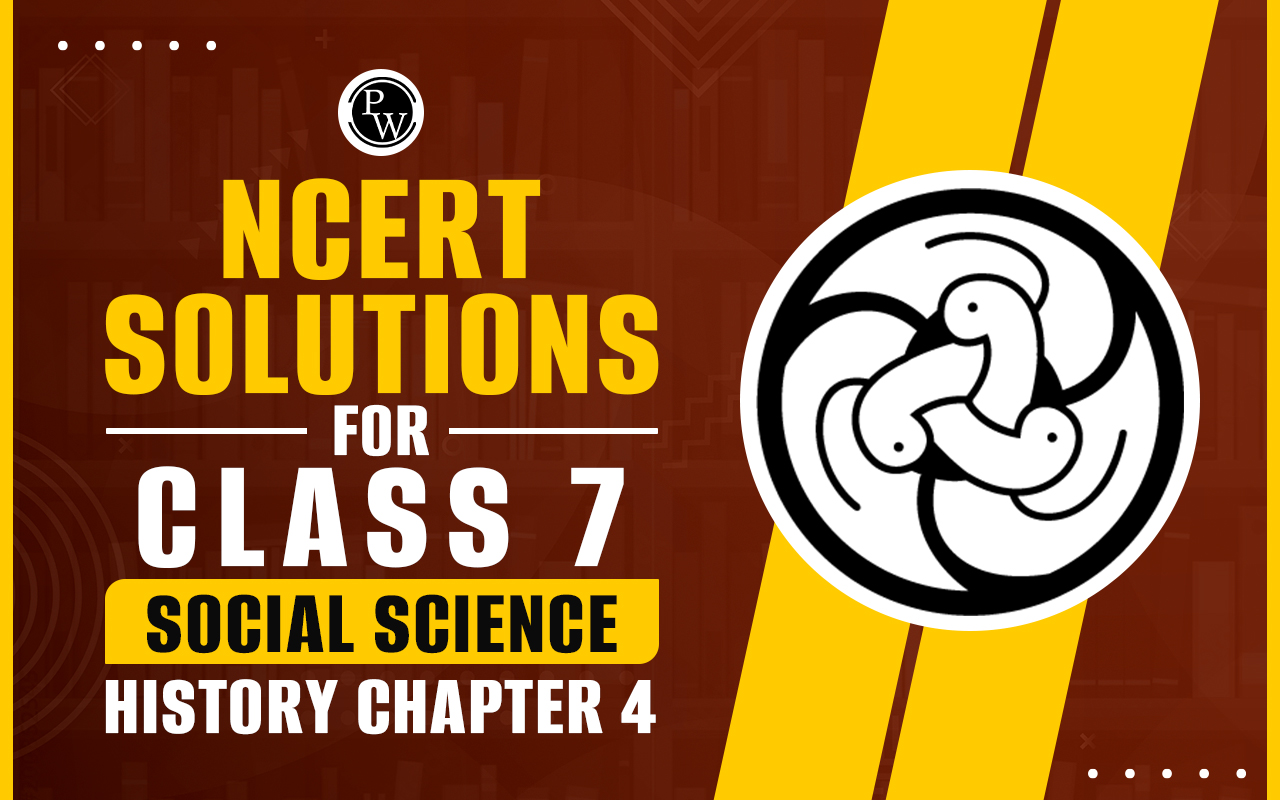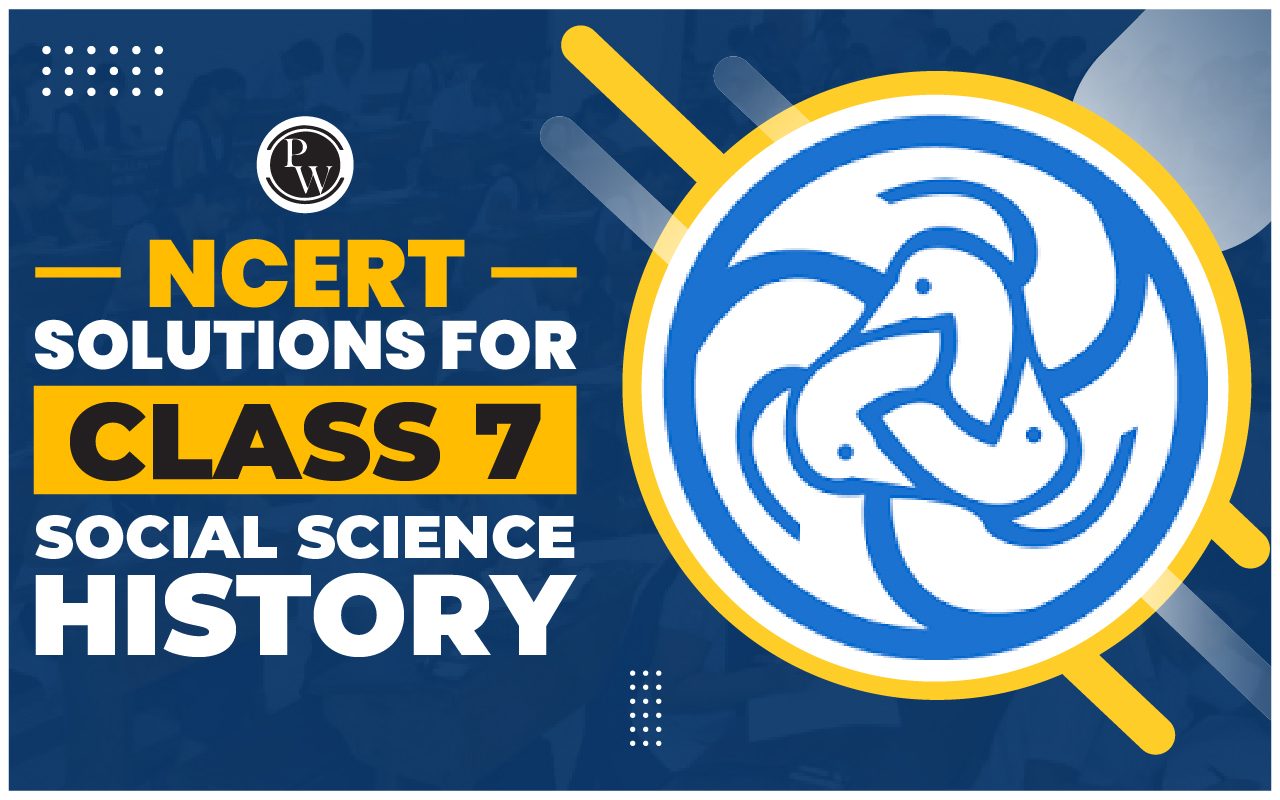

NCERT Solutions for Class 7 Social Science History Chapter 4
NCERT Solutions for Class 7 Social Science History Chapter 4: NCERT Solutions for Class 7 History Chapter 4, "The Mughal Empire," are meticulously crafted by experts at Physics Wallah. These solutions provide comprehensive answers to the questions asked in the NCERT book. Chapter 4 explores how the Mughals expanded their kingdom from Agra and Delhi, starting from the latter half of the 16th century. By the 17th century, the Mughals had gained control over nearly the entire Indian subcontinent. The Mughals introduced structures of administration and ideas of governance that are still practised beyond their rule. In fact, the Mughals left behind a political legacy that the subsequent rulers of the subcontinent could not ignore. PW offers reliable study materials for Class 7 History Chapter 3, guiding students in a clear manner to facilitate easy comprehension and successful examination performance. Proficient educators at Physics Wallah create NCERT Solutions for Class 7 Social Science History Chapter 4 enabling students to tackle their exams with confidence and get good scores by following these answers and notes.NCERT Solutions for Class 7 Social Science History Chapter 4 PDF Download
NCERT Solutions for Class 7 Social Science History Chapter 4 Overview
Ruling a vast territory like the Indian subcontinent, with its diverse people and cultures, was an exceedingly challenging task during the Middle Ages. However, in contrast to their predecessors, the Mughals established an empire and achieved what had previously seemed possible only for short periods of time. The Mughals expanded their kingdom from Agra and Delhi, starting in the latter half of the 16th century, and by the 17th century, they controlled nearly the entire Indian subcontinent. They implemented administrative structures and governance ideas that outlasted their rule. This left a political legacy that succeeding rulers of the subcontinent could not ignore. Chapter 4 of the CBSE Class 7 History focuses on concepts related to the Mughal Empire. NCERT Solutions for Class 7 Social Science History Chapter 4 The Mughal Empire has the answers to the exercises given in the textbook "Our Pasts-II."NCERT Solutions for Class 7 Social Science History Chapter 4 The Mughal Empire
NCERT Solutions for Class 7 History Chapter 4 The Mughal Empire are provided here with simple step-by-step explanations. 1. Match the following:| Mansab | Marwar |
| Mongol | Governor |
| Sisodiya Rajput | Uzbeg |
| Rathor Rajput | Mewar |
| Nur Jahan | Jahangir |
| subedar | Rank |
| Mansab | Rank |
| Mongol | Uzbeg |
| Sisodiya Rajput | Mewar |
| Rathor Rajput | Marwar |
| Nur Jahan | Jahangir |
| subedar | Governor |
(c) If zat determined a mansabdar’s rank and salary, sawar indicated his ______. If zat determined a mansabdar’s rank and salary, sawar indicated his specific number of cavalrymen. (d) Abul Fazl, Akbar’s friend and counsellor, helped him frame the idea of _____ so that he could govern a society composed of many religions, cultures and castes. Abul Fazl, Akbar’s friend and counsellor, helped him frame the idea of sulh-i kul so that he could govern a society composed of many religions, cultures and castes. 3. What were the central provinces under the control of the Mughals? Mughals controlled several central provinces which they called subas. Most subas, total 22, were recorded under the rule of Aurangzeb. They were namely—Kabul, Kashmir, Lahore, Multan, Delhi, Agra, Awadh, Illahabad, Bihar, Bangal, Orissa, Malwa, Ajmer, Gujrat, Golkonda, Berar, Bijapur, Thatta, Khandesh, Aurangabad, Bidar and Sira. 4. What was the relationship between the mansabdar and the jagir?
- The mansabdari system was administered during the rule of Mughal emperor Akbar.
- The mansabdars were high ranking officials who joined the royal service under the Mughal government.
- The mansabdars received a certain salary for their service from the empire which defined their rank. The rank and salary were also called zat which defined their position in the royal court.
- One of the assignments of the mansabdars is to collect revenues from certain areas. This area is referred to as jagir.
- The mansabdar mostly did not reside in the jagir but sent his men from his service to collect revenues, while they served the king in other parts of the empire.
- In the Mughal administration, the zamindars were used to collect revenue directly from the peasants. They were the connection between the peasants and the sovereign.
- In rural areas, the zamindars acted as village chieftains in absence of any other official from the Mughal court. Sometimes zamindars and peasants of equal castes together rebelled against the ruler.
- Akbar, the greatest ruler of the Mughal dynasty, was curious about religious and social customs. To quench his interests, he often used to arrange debates among scholars of different religions.
- Various information learned from those debates helped him to understand that religious texts and leaders of different religions emphasise more on rituals and dogma to give rise to bigotry, which caused divisions and disrupted the harmony of the society.
- Thus, he created the idea of ‘universal peace’ or ‘sulh-i-kul’, which emphasised tolerance, justice, peace throughout the society irrespective of religion or caste.
- Akbar’s minister and writer Abul Fazl helped him in building this vision of governance and was later followed by Akbar’s son Jahangir and grandson Shah Jahan during their rule as well.
- Ghengis Khan, the great Mongol emperor and his army of Huns left a trail of massacre and destruction behind him over the larger part of central Asia.
- Though Indian history remembers Timur Long similarly, Mughals took great pride in that he seized Delhi in 1398. The Mughal kings wanted to see themselves as Timur.
- Thus, Mughal rulers emphasised more of Timur as their ancestor compared to Mongol king Ghengis Khan.
| CBSE Syllabus Class 7 | |
| CBSE Class 7 English Syllabus | CBSE Class 7 Math Syllabus |
| CBSE Class 7 Social Science Syllabus | CBSE Class 7 Science Syllabus |
- The Mughal empire’s main income source was revenues collected from peasants and from agricultural products. This money was collected by the zamindars and submitted to the Mansabdars. They put the money into the Mughal treasury.
- Salaries of soldiers, government workers, tasks for the welfare of the commoners were paid from those taxes.
- To keep law and order over the empire, land revenue was the most important income source.
- When the first mansabdari system was introduced by Mughals, they first recruited Turkish noblemen or Turanis and the Persian nobleman or Iranians as mansabdar.
- Later Muslims of Indian descent, Afghans, Rajputs, Marathas, and people from other backgrounds were also recruited as mansabdars.
- The reason behind recruiting mansabdars from diverse communities was to gain the trust of common people and to create a balance of power in the administration.
- This discussion helped the Mughals to expand and solidify their hold over various regions and provinces.
NCERT Solutions for Class 7 History Chapter 4 The Mughal Empire Topic-Wise Discussion
Who were the Mughals? Descendants of Genghis Khan and Timur, the Mughals avoided the terms "Mughal" or "Mongol" due to negative associations with Genghis Khan's brutal reputation and conflicts with the Uzbegs. They took pride in their Timurid ancestry, celebrating their great ancestor's capture of Delhi in 1398. Mughal Military Campaigns Babur, the first Mughal emperor, seized Kabul in 1504 and defeated Sultan Ibrahim Lodi at Panipat in 1526, capturing Delhi and Agra. The Mughals had a unique tradition of succession, rejecting primogeniture and following coparcenary inheritance, dividing inheritance among all sons. Mughal Relations with Other Rulers Mughal rulers campaigned constantly against rulers who refused to accept their authority. However, as they became powerful many rulers like the Rajputs joined them voluntarily. Many of the Rajputs married their daughters into Mughal families and received high positions. Many resisted as well. For example, Sisodiya Rajputs of Mewar refused to accept Mughal authority. However, upon defeat, they were honourably treated by the Mughals, given their lands (watan) back as assignments (watan jagir). This careful balance between defeating but not humiliating their opponents enabled the Mughals to extend their influence over many kings and chieftains. However, it was difficult to keep this balance all the time. A Closer Look: Akbar’s Policies Akbar's policies, detailed by Abul Fazl in "Akbar Nama" and "Ain-i Akbari," structured provinces as subas, each governed by a subadar overseeing political, judicial, and military matters. The administrative roles included a financial officer (diwan), military overseer (Bakshi), and ministers for religious and charitable affairs (sadr) and peacekeeping (faujdars). Nobles, with vast armies and revenue access, ensured efficient empire functioning, although by the late 17th century, their loyalties weakened. The Mughal Empire in the 17th Century and After The effective management in both administration and the military resulted in significant economic and trade success. Travellers from around the world depicted it as a legendary land of prosperity. However, alongside great wealth, there were also areas experiencing poverty. The disparities were evident. Records from the 20th year of Shah Jahan’s rule reveal that the highest-ranking officials, known as mansabdars, were only 445 out of 8,000, which is about 5.6%. Surprisingly, they received 61.5% of the total estimated empire revenue as salaries for themselves and their soldiers. These officials spent a considerable portion of their income on salaries and goods, benefiting artisans and peasants who supplied them. However, the extensive revenue collection left little for investment in the hands of the primary producers, such as peasants and artisans. The poorest struggled to meet their basic needs and couldn't invest in additional resources to enhance productivity. On the other hand, wealthier peasants, artisans, merchants, and bankers thrived in this economic environment. The immense wealth and resources controlled by the Mughal Elite made them extremely influential in the late 17th century. As the Mughal Emperor's authority declined, his servants became powerful centres of influence, establishing new dynasties and governing provinces like Hyderabad and Awadh. Despite this, they continued to acknowledge the Mughal emperor in Delhi as their leader. By the 18th century, the empire's provinces solidified their independent political identitiesBenefits of NCERT Solutions for Class 7 History Chapter 4
NCERT Solutions for Class 7 Social Science History Chapter 4 offer numerous benefits that significantly contribute to students' understanding and mastery of the subject. Let's delve into the advantages in detail: 1. Concept Clarity: NCERT Solutions provide clear explanations and solutions to the exercises in Chapter 4. This aids in the comprehension of historical concepts related to The Mughal Empire, ensuring students have a solid foundation of the subject matter. 2. Exam Preparation: The solutions are specifically designed to assist students in preparing for their exams. By following the provided answers and explanations, students can familiarise themselves with the types of questions likely to appear in the exams, enabling them to approach their exams with confidence. 3. Doubt Resolution: NCERT Solutions act as a valuable resource for resolving doubts. The detailed solutions help students understand complex topics, and any lingering doubts can be clarified by referring to the provided answers. 4. Enhanced Learning Experience: Real-life examples and demonstrations featured in the solutions contribute to a more engaging learning experience. This approach makes historical concepts more relatable and accessible, fostering a deeper understanding of the subject. 5. Skill Development: The solutions aid in the development of essential skills such as critical thinking and analytical reasoning. By working through the exercises and understanding the solutions, students hone their ability to analyse historical events and draw logical conclusions. 6. Accessibility: NCERT Solutions are available in a simple and accessible format, making them easy for students to use. The solutions can be easily accessed and downloaded, providing a convenient study resource. 7. Guided Study: The solutions are designed by expert tutors, ensuring a guided and structured approach to studying Chapter 4. This helps students stay focused and organised in their study sessions. 8. Overall Academic Success: By utilising NCERT Solutions, students can reinforce their understanding of key historical topics. This, in turn, contributes to their overall academic success in Social Science History Class 7, as they are better equipped to tackle exams and assignments. 9 . Application of Knowledge: The solutions encourage the application of historical knowledge to different scenarios. By presenting questions that require critical thinking and application, students develop the ability to apply historical concepts in various contexts. 10. Cultural Awareness: Chapter 4 may include information about different cultures and civilizations. NCERT Solutions help students develop cultural awareness by presenting diverse historical perspectives and traditions.How to Prepare with NCERT Solutions for Class 7 Social Science History Chapter 4
Preparing with NCERT Solutions for Class 7 Social Science History Chapter 4 involves a strategic approach to understanding historical events and concepts. Here's a detailed guide on how to effectively prepare using these solutions:- Read the Chapter Thoroughly: Begin by reading Chapter 4 of Class 7 Social Science History carefully. Pay attention to the details, events, and historical developments mentioned in the chapter.
- Understand Key Concepts: Focus on understanding the key historical concepts presented in the chapter. Identify significant events, dates, and the historical context surrounding them.
- Use NCERT Solutions: Access the NCERT Solutions for Chapter 4. Go through the solutions for each exercise and question. These solutions provide step-by-step explanations and answers to help you understand historical events more comprehensively.
- Take Notes: While going through the NCERT Solutions, take notes on important points. Summarise key events, historical figures, and their contributions. Create a condensed set of notes for quick revision.
- Engage in Self-assessment: Attempt to solve the exercises and questions independently before referring to the solutions. This self-assessment helps identify areas of strength and weaknesses, guiding your further preparation.
- Map Reading Skills: If the chapter involves maps, practise your map-reading skills. Understand the geographical locations mentioned in the historical context. Use the maps provided in the NCERT textbook.
- Connect Events Chronologically: Establish a chronological order of historical events. Connect events in a timeline to visualise the progression of history during the period covered in the chapter.
- Supplement with Additional Resources: Use additional historical resources, reference books, or online materials to supplement your understanding. This broader exploration can offer alternative perspectives and enrich your historical knowledge.
- Discuss with Peers: Engage in discussions with classmates or study groups. Sharing perspectives and discussing historical events can provide new insights and reinforce your understanding.
- Create Flashcards: Create flashcards for key terms, dates, and historical figures. Regularly review these flashcards to reinforce your memory and recall important information during exams.
- Practise Previous Years' Questions: Practise solving questions from previous years' exams. This helps you become familiar with the question patterns and prepares you for the types of questions that may appear in the exam.
NCERT Solutions for Class 7 Social Science History Chapter 4 FAQs
How were the Mughals greater than their predecessors?
Unlike their predecessors, the Mughals created a huge empire and accomplished what had hitherto seemed possible for only short periods of time. From the latter half of the 16th century, they expanded their kingdom from Agra and Delhi until in the 17th century they controlled nearly all the subcontinent.
How did Babur became the ruler of Delhi?
Babur succeeded to the throne of Ferghana in 1494 when he was only 12 years old. Babur wandered for several years. Then in the year 1504, he seized Kabul. In 1526 he defeated the Sultan of Delhi, Ibrahim Lodi, at the battle of Panipat. Thus, he captured Delhi where he laid the foundation of the Mughal Empire. He became the first Mughal emperor and ruled from 1526 to 1530.
Who were mansabdars? What were their responsibilities?
The Mughals recruited diverse bodies of people in order to run the empire smoothly. Those who joined Mughal service were enrolled as mansabdars. The mansabdars were assigned to military responsibilities. For this they maintained a specified number of sowar or cavalrymen. The mansabdar brought his cavalrymen for review, got them registered, their horses branded and then received money to pay them as salary.
Who built the first Mughal Empire?
The first Mughal Empire was established by Babur in 1526 after his victory at the Battle of Panipat. Babur, a descendant of Timur and Genghis Khan, laid the foundation for the Mughal dynasty in India.
What were some of the major campaigns and events of Akbar’s reign?
Akbar’s reign can be divided into the following three periods - 1556-1570, 1570-1585, and 1585-1605.
🔥 Trending Blogs
Talk to a counsellorHave doubts? Our support team will be happy to assist you!

Check out these Related Articles
Free Learning Resources
PW Books
Notes (Class 10-12)
PW Study Materials
Notes (Class 6-9)
Ncert Solutions
Govt Exams
Class 6th to 12th Online Courses
Govt Job Exams Courses
UPSC Coaching
Defence Exam Coaching
Gate Exam Coaching
Other Exams
Know about Physics Wallah
Physics Wallah is an Indian edtech platform that provides accessible & comprehensive learning experiences to students from Class 6th to postgraduate level. We also provide extensive NCERT solutions, sample paper, NEET, JEE Mains, BITSAT previous year papers & more such resources to students. Physics Wallah also caters to over 3.5 million registered students and over 78 lakh+ Youtube subscribers with 4.8 rating on its app.
We Stand Out because
We provide students with intensive courses with India’s qualified & experienced faculties & mentors. PW strives to make the learning experience comprehensive and accessible for students of all sections of society. We believe in empowering every single student who couldn't dream of a good career in engineering and medical field earlier.
Our Key Focus Areas
Physics Wallah's main focus is to make the learning experience as economical as possible for all students. With our affordable courses like Lakshya, Udaan and Arjuna and many others, we have been able to provide a platform for lakhs of aspirants. From providing Chemistry, Maths, Physics formula to giving e-books of eminent authors like RD Sharma, RS Aggarwal and Lakhmir Singh, PW focuses on every single student's need for preparation.
What Makes Us Different
Physics Wallah strives to develop a comprehensive pedagogical structure for students, where they get a state-of-the-art learning experience with study material and resources. Apart from catering students preparing for JEE Mains and NEET, PW also provides study material for each state board like Uttar Pradesh, Bihar, and others
Copyright © 2025 Physicswallah Limited All rights reserved.
Get App










